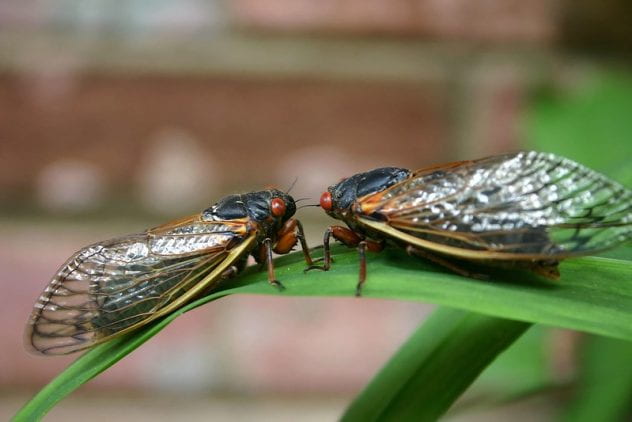
Magical Magicicada
The largest emergence
of periodical cicadas
is coming. Brood X’s lives begin
when laid by their mamas in the treetops
in 2004. The tiny nymphs hatch and
soon take a leap of faith
from the crown of bounty
to the ground below
burrowing in to find roots
under the thicket of their birth,
where they suckle on the sap–
xylem, their drink of choice
They live in the netherworld
sucking and digging
Developing those eyes, the ancients say,
by staring into the fires of Hades
Benjamin Banneker,
mathematician,
astronomer,
writer, and
skillful life observer
followed Brood X
(before it was called Brood X)
from 1749, 1766, and 1783,
then predicted their 1800 emerging.
Before he noticed the pattern,
the cicadas still punctually
made their prime time
passage to paradise for
many millennia.
Since 1800, as Banneker declared,
like clockwork, the majority of Brood X
burrows up every 17 years
(some stragglers come in years
before and after their designated showing)–
1800, 1817, 1834, 1851, 1868, 1885,
1902, 1919, 1936, 1953, 1970, 1987,
2004, 2021, and so on into the future.
Billions or trillions are coming
when the soil temperature warms
and they make a break for it.
Then they will have work to do.

First, they split
their skin and escape
from their nymph stage
molting overnight,
taking time
to dry out
their new duds
Next, it’s time for these teens
to find love with a two-part concert
Big boy band sings cicada songs
Because males are the only ones
who tote the musically-
impressive tymbal organ.
Paired with their mostly hollow abdomen
these kettledrums of insecta
amplify their sound up to 100 decibels.
The first in their set is Song of Sorting–
Magicicada septendecim
Magicicada cassinii
Magicicada septendecula
each of the three Brood X species
congregate onto different trees.
Then they are ready for their
segregated second song in the set
called Courtship Song
The father of future nymphs
sings a mating tune
to woo his partner
In the meantime, though,
predators aplenty
are feasting on the
fresh flesh of the
recently-arrived cicadas.
Neighborhood cats and dogs,
possums, birds, squirrels,
bats, wasps, spiders
and even humans.
None planned this menu, but
everyone eats cicadas.
But no worries: Brood X
overwhelms the enemies
with their blessed bulk of billions,
allowing their predators to
indulge in a gluttonous gorge,
like a long Thanksgiving day.
In predator satiation
everyone gets a full tummy.
Finally the remaining are safe,
which is enough–
Survival of the leftovers.
The leftovers not only survive,
but they thrive to carry on their species.
The female responds to the mating tune
She flicks her wings in a sassy yes
to courtship and procreation.
They mate and then separate–
The male to sing and score again,
The female to climb higher
and lay hundreds of eggs
in twigs of branches in the tree.
These cicadas who’ve make it
safely through the feeding frenzy
of the predators
are among the longest-living
insects in the world. Though,
they stumble into the daylight
while already in their twilight.
In just a month to six weeks.
the adults are dead.
The process continues.
Nymphs leap into
their future
and life goes on–
we pray–until we await
their visit in 2038.

Today I was inspired by “The Story of a Poem” with Shirley McPhillips for National Writing Project. Shirley challenged us to write a poem with alliteration, assonance and consonance–to think about the way the poem sounded when read aloud. I managed to put at least some of each of those in the poem. Also, because Shirley did research on the sweet little mice that like to fit into flowers and wrote her poem about them. I also chose to do some research. I am fascinated this year with the emergence of the Brood X cicadas, so I did research on the genus Magicicada and wrote the poem above. My research led me to so many interesting people who study cicadas. Many facts and phrases in my poem were found in the sources in the links below. Many thanks to Jeffrey Brown and John Yang at PBS News Hour, The Bug Guy Mike Raupp, Dan at Cicadamania and Julian Huguet for inspiring my writing in “Magical Magicicada.” Thanks to Tracy Lee for sharing Brood X’s photos from 2004 on Flickr with a Creative Commons license.
Mike Raupp, entomologist at University of Maryland in 2004 and 2021
Dan from Cicadamania.com